New Boston Historical Society
New Boston, New Hampshire
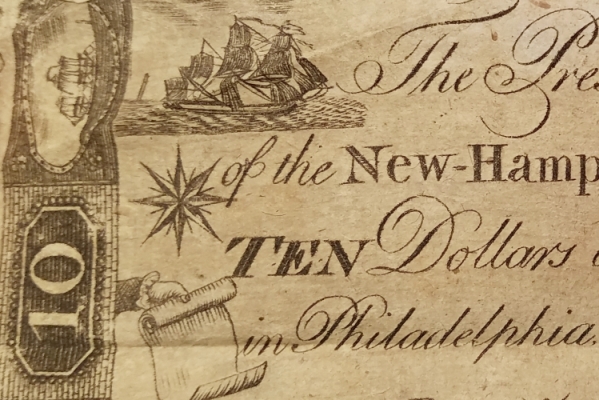
Detail of a Ten Dollar Banknote printed in New Boston
Counterfeiters Arrested in New Boston!
Part 2: The Search Continues
State of New Hampshire Archives and Records Management
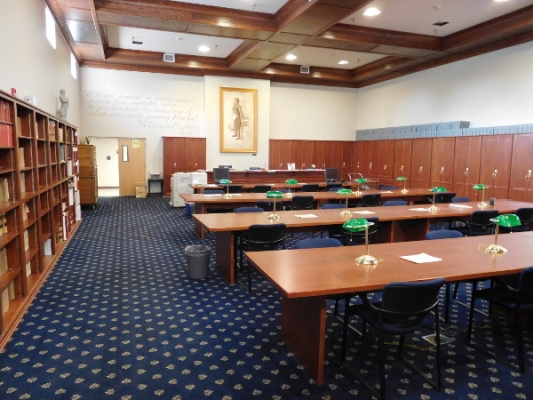
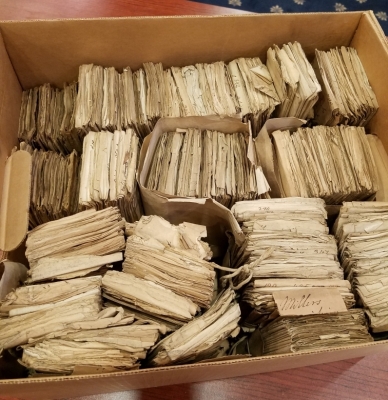
The Archives in Concord has the 1804 Court Records for Hillsborough County.
How exciting it was to hold "banknotes" printed by the Call gang over 200 years ago, seized by authorities in the New Boston home of John Lynch! Jennifer could see the fine detail of the printing — banks intended that this would make the notes more difficult to counterfeit.
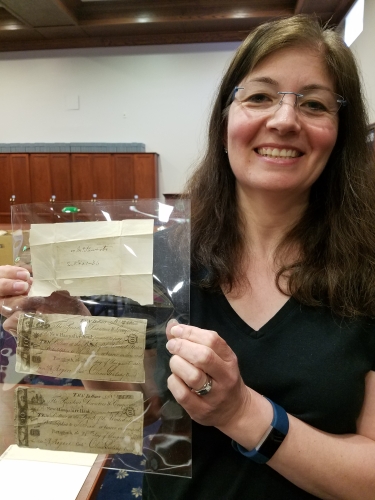
Jennifer placed the banknotes in special archival-quality plastic envelopes.
Each was slightly larger than a modern dollar bill.

- William Johnson Ayres [Ayers]
- Phineas Bayley [Bailey]
- Ephraim Bayley [Bailey]
- Timothy Call
- William Gillman [Gilman]
- John Silver
- John Stewart
John Stewart was in jail for counterfeit money and also for "Breaking [into] Dr. Luke Lincoln's Store." Dr. Lincoln was both a medical practitioner and a New Boston businessman. His brief biography in Cogswell's 1864 "History of New Boston" reads:
Dr. Lincoln succeeded Dr. Eastman ; was a pleasant man but not very skilful ; was an enterprising citizen, built a store and mills, but, becoming intemperate, met with reverses, and left town."Intemperate" in this context meant that he indulged in alcohol to excess. Dr. Lincoln was not a lucky man; Jennifer discovered that in February of 1804, Dr. Lincoln lost his only daughter, age 9, in a tragic fire. This was not long after his New Boston store had been "broken open" by John Stevens in December 1803; "cash and notes to the amount of 1,000 dollars were taken." It is no wonder that the poor man took to drink.
Jennifer left the Archives with scans of more than 100 pages of court documents. The handwriting is legible, but we expect that it will take weeks to review the pages and interpret their contents. We believe that one particularly interesting document will shed some light on the arrest of the New Boston counterfeiters in April of 1804. This page will be updated as we learn more.
Escape from Jail
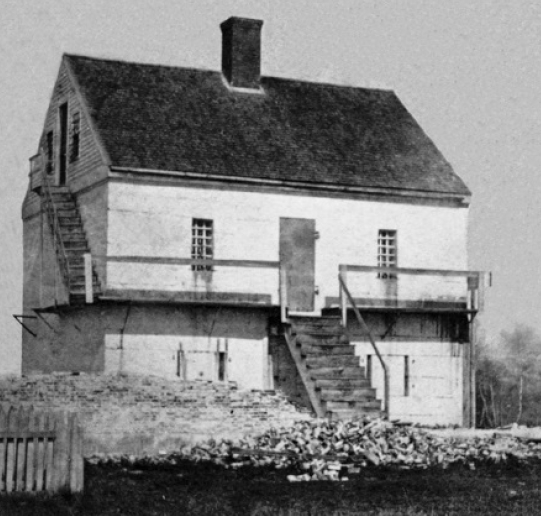
The Historical Society of Amherst, NH tells us that the Old Jailhouse
in this photo was built in 1811 from the stones of the previous jail.
- Timothy Call is about five feet five inches high, stout built, dark complexion, sandy hair, considerably freckled, middle aged.
- David Call is about six feet high, dark complexion, black eyes, and dark hair, about forty years old.
- William Gilman, about five feet six inches, fair countenance, black eyes and hair, about 25 years of age.
- John Silver, about five feet seven inches high, light complexion, bald on top of his head, middle aged.
- John Stewart, about five feet eight inches high, brown hair, blue eyes, about twenty four years old.
- William J. Ayers, about five feet eleven inches, dark hair and eyes, middle aged.
- Ephraim Bailey, about five feet five inches, black hair, full black eyes, swarthy complexion, a deep scar on his cheek, about twenty seven years old.
The Key to the Escape?
The article in The Vermont Gazette adds an interesting detail to the story of the New Boston counterfeiters' escape: "a pewter key, which was used in unlocking the outer door, was found a few rods from the gaol, between that and the bridge below the prison." (The old jailhouse was located on what is now called Old Jailhouse Road, near today's Amherst Town Hall; the nearest bridge was where the Manchester Road crossed Beaver Brook.)What does this key tell us about the escape? Pewter, an alloy of tin, is a relatively soft metal, and it seems unlikely that a professional locksmith employed by the Amherst jailer would choose pewter to make a key. Did someone else make an unauthorized duplicate key?
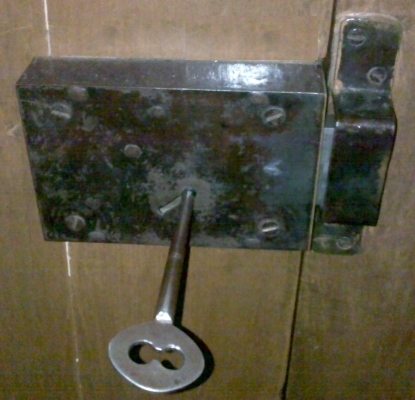
A "warded lock" c.1800 would be easier than a modern "tumbler lock" to open with a home-made key.
(Photo from Wikipedia)
Does the more successful use of a pewter key in the Amherst jail escape indicate that the jailer was not complicit; that someone made a copy of his key? Or did the counterfeiters bribe the jailer to release them, and drop a duplicate key where they knew it would be found, to confuse the authorities?
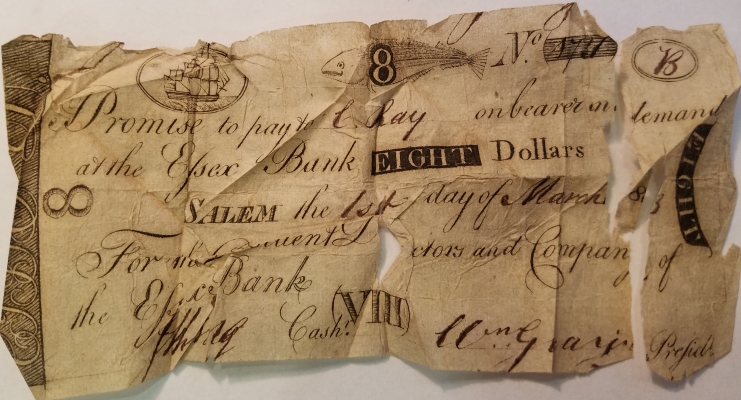
Eight Dollar Banknote printed in New Boston
A Repeat Offender?
"ESCAPED from the State's Prison, on the night of the 20th inst. four Convicts, by the names of Samuel Hemingway, Daniel Wilbour, William Gilman, and Ezekiel Flanders... Gilman is 27 years of age, 5 feet 7 and one quarter inches high, dark grey eyes, black hair and dark complexion." (The escapees wore prison uniforms made of green and red cloth.)
Compare that description to one from the 1804 Amherst jailbreak: "William Gilman about five feet six inches, fair countenance, black eyes and hair, about 25 years of age." It seems possible that this was the same man!
Our investigation continues. We still don't know what John Lynch's connection to the counterfeiters was — whether he was an accomplice, or an unwitting host. While looking for more information about the Mr. Lynch (who may have been a blacksmith at one time), we were intrigued by this entry in Cogswell's "History of New Boston":
May 22, 1855, Mr. John Lynch, in the west part of the town, was found dead in his pasture, the contents of a musket having passed into his head, accidentally, as was believed by his friends.However, we found that our John Lynch died in 1840; it was his son John Lynch, Jr. who died in 1855 (or 1858, depending on your source), "accidentally, as was believed by his friends."
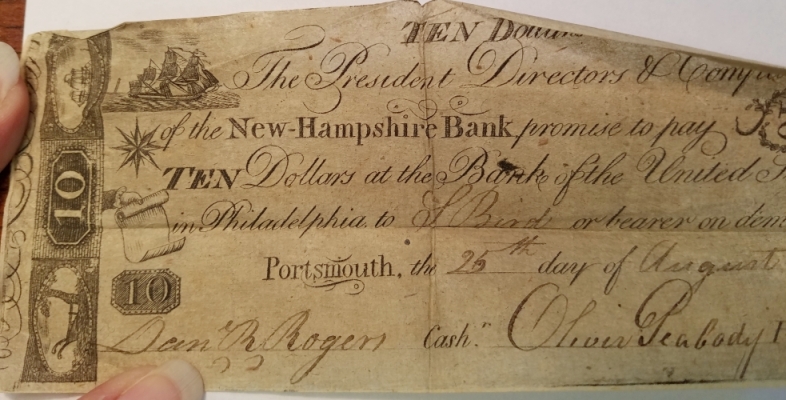
Anti-counterfeiting Measures
We mentioned earlier that the fine detail of the artwork and lettering was intended to make a banknote more difficult to counterfeit. Banknotes of the time were printed on one side only, using a process called "intaglio" (in-tal-yoh) in which the design is incised (scratched) into a copper plate. Ink is applied to the plate and then wiped off, leaving ink only in the valleys of the incised engraving. Paper is pressed into the plate, and the ink is transfered. (Contrast intaglio with the method used to print books and newspapers, where ink is applied to the top surface of blocks of moveable type.)
Mr. Tuck's papers in Part 1 of this story identified the engraver of the New Boston plates as a Mr. Peaslee or Peasley, probably a Massachusetts man. We knew nothing more about him when this page was written; however in 2024 we received an interesting email from a knowledgeable reader:
2024 update: We are grateful to a button-collector named Kevin Rosentreter for detailed information about the engraver Aaron Merrill Peasley (1775-1837). Kevin wrote to us: "In April and May of 1804 Peasley was arrested in Newburyport, MA and convicted in Ipswich, MA for counterfeiting banknotes. For the possession of counterfeit bank note plates made for Beverly Bank notes and the possession of tools to make counterfeit plates, he was sentenced to 5 years in jail and hard labor, but as a follow on sentence he could serve another 5 years if he did not pay restitution for his crime... Peasley submitted multiple petitions for an early release because of his reformation in jail and being 'seduced to be an instrument' to make the counterfeit plates. Peasley was pardoned in October of 1808." He later became a famous button-maker and inventor, with his own Wikipedia entry. Kevin Rosentreter concluded: "Peasley's legacy continues; his insignia of an American Bald Eagle holding a fouled anchor with an arc of 13 stars is still used to this day on Marine Corps Dress and Service Alpha uniform [buttons]."
A Note to Our Readers
Please let us know if you have any information that may lead to the re-arrest of the New Boston counterfeiters! We offer a reward of eight dollars, which we'll print for you on our copying machine.